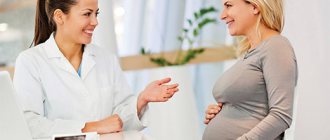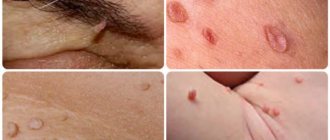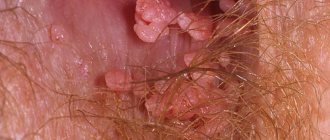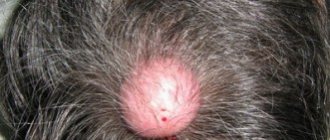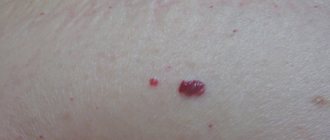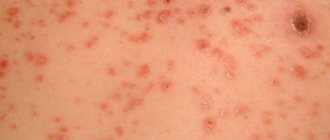Papilloma is a neoplasm that can grow in various parts of the body, both on the skin and mucous membranes. Such growths are an external manifestation of human papillomavirus infection, which currently occurs in more than 80% of people living in different countries of the world.
Human papillomavirus infection is transmitted both through sexual contact and in domestic conditions. Children can become infected during childbirth, when passing through the birth canal. Neoplasms can appear not only on the skin. There are strains of this virus that affect internal organs, such as the bladder. Today there are papillomas that have different shapes and sizes. They can be almost invisible, or they can hang over the affected area of the epidermis or in appearance resemble an overgrown head of cauliflower.
Nevi
Synonyms for the name are mole, birthmark. In essence, all these neoplasms are pigmented nevi (naevus). These are accumulations of nevocytes - skin cells containing a lot of melanin (the pigment responsible for the color of the integument, hair and iris of the eyes).
It is believed that such elements are formed in the fetus in the womb. Some of them appear immediately after birth (4–10%), others during puberty (up to 90%), and others throughout life under the influence of environmental factors. 75% of Caucasians have moles.
Among the causes of malformations of the skin of the unborn baby, there are unfavorable factors to which the woman’s body was exposed during pregnancy:
- hormonal changes - sharp jumps in estrogen and progesterone;
- genitourinary system infections, sexually transmitted diseases;
- intoxication with poisons, alcohol;
- genetic disorders.
There are about a hundred varieties of pigmented nevi. They are located in the superficial epithelium, at the border of the epidermis and dermis or directly in the dermis.
Moles can be flat or raised above the integument, ranging in size from 1 mm to several tens of centimeters. If the spot occupies most of the skin, then it is called giant. Hairs may grow on the surface. Other neoplasms are also classified as nevi:
- hemangiomas - red vascular tumors;
- nevi of the sebaceous glands - do not contain melanin and are localized mainly on the head;
- anemic spots - light areas with a cluster of underdeveloped blood vessels.
The most dangerous type is dysplastic (atypical) nevi, found in 5% of people on the planet. They are initially prone to degeneration into a malignant tumor, and therefore require constant monitoring. This is a transitional form between a regular mole and melanoma or a precancerous condition.
The following symptoms of malignancy of any nevus should alert you:
- change in size, shade;
- bleeding;
- itching, pain, feeling of tension, tingling;
- transformation of a smooth surface into a rough one, the appearance of tubercles, cracks and foreign inclusions;
- changing the shape and smoothing the contours of the spot;
- peeling of the skin.
Diagnosis is carried out through visual examination, a magnifying glass or fluorescent microscope, laboratory tests, and a computer. In case of danger, the nevus is surgically removed along with part of the healthy integument and fatty tissue.
Brown
Brown papillomas occur in more than 80% of the world's inhabitants and are considered normal for humans. In the world they are called moles.
Can melanoma be brown? Yes, but the transformation of HPV into cancer is accompanied not only by a change in color, but also by other symptoms. Therefore, if a mole does not bother you, does not grow, does not itch, or changes color, there is no need to worry. However, you should not try to get rid of it at home. This can lead to inflammation and infection, which in turn can lead to the appearance of a malignant formation.
Papillomas
They're warts. Benign tumors in the form of a papillary-shaped soft growth on a stalk or broad base.
They look like cauliflower. The reason for their appearance is the human papillomavirus (HPV), the carriers of which account for more than 60% of the world's population.
Some strains of the pathogen do not cause harm. Others cause warts or genital warts.
There are also those that have oncogenic properties and lead to the growth of malignant tumors, cervical cancer in women and intimate organ cancer in men. Viruses with high oncogenicity include strains 16, 70, 18, 68, 31, 59, 64, 50, 33, 39.
The microbe is transmitted from an infected person during sexual contact, touch (penetrates through injuries and open wounds with blood), and to a newborn from the mother. Self-infection and spread of papillomas to healthy areas of the skin due to injury are possible.
The incubation period lasts several years. The carrier is not even aware of the infection, continuing to spread the virus to other people.
Vulgar, simple or ordinary. They are caused by HPV types 2 and 3. They grow on the back of the hands, fingers, palms, and have a dense texture.
The growths are round or spherical, covered with a stratum corneum of epithelium, and have a root extending deep into the dermis. The surface is cracked, without a skin pattern, there are foreign inclusions.
The color is gray, pink, dirty yellow, flesh or brown. There are paired formations where the maternal wart is larger.
Plantar or spinules. They occur on the toes and soles (heels, balls of the feet and toes) as a result of infection with HPV types 1, 2, 24, 27, 57.
Due to constant pressure when walking, such a wart grows deep inward and wide. It hurts, hard and rough to the touch.
Black dots can be seen inside – capillaries clogged with blood clots. Externally it resembles a callus.
Flat, youthful, juvenile. They are more common in adolescents and children and are caused by HPV types 3 and 10.
These are multiple rounded nodules or plaques that practically do not rise above the surface of the skin (height up to 5 mm).
Localized on the face, neck, back of the hands, knees. Their shade depends on the color of the integument and can be gray, purple, brown and even blue.
Filiform (acrochords). The neoplasms are round or oblong in shape and small in size - up to 5 mm.
It can affect the areas of the neck, eyelids, around the eyes and nose. In women, thread-like elements are found under the breasts and in the axillary area.
It has been established that they occur in places with increased sweat production. The culprit is HPV types 9, 8, 3 and 5. Can be single or multiple.
Genital warts (anogenital). These are small and numerous pink growths that form as a result of infection with HPV, most often types 6, 11, 42 and 44.
Fusing with each other, they form soft, papillary-shaped elements of pink or red color on a thin stalk. They are found on the genitals, in the groin, in the intergluteal folds, and on the mucous membranes.
Senile (seborrheic keratosis). Not associated with viral infection. Appears in older people due to skin aging.
Their color is dark brown or black, the surface is oily and loose, shiny. They are shaped like beads.
There are no drugs that can destroy the papilloma virus in the body. Therefore, treatment is aimed at long-term remission of the disease. All warts must be removed because they pose a risk of infection to other people. There are several drastic ways:
- surgical route. Rarely used due to contact with blood and the risk of infection of patients and medical personnel;
- laser excision;
- electrocoagulation;
- cryodestruction;
- chemical cauterization;
- radio wave knife.
Read more about methods for removing tumors here.
To strengthen the immune system, antiviral, immunomodulating systemic and external agents and vitamins are prescribed. To protect the younger generation from oncogenic strains that cause cervical cancer, vaccination is successfully used in the United States. In Russia, vaccination is paid.
What causes the appearance of black dots on a mole?
Every person is the owner of moles. The reason for the appearance of these formations is melanin, which accumulates in certain areas of the body. The nevus may disappear or, on the contrary, become more noticeable over time. The presence of pigment in these formations is maximum, but melanin is not able to protect itself from ultraviolet radiation, which makes exposure to UV rays destructive for them and provokes malignant degeneration of cells, the primary symptom of which can be black dots on a mole.
People who have light skin tones or are more likely to stay indoors are more susceptible to melanoma than others: the sun's impact is so intense that the skin can't stand it. This leads to a failure, which greatly increases the risk of the nevus turning into a cancerous tumor. Light skin and hair, freckles make it necessary to avoid excessive exposure to direct sunlight.
Etiology
Black dots on nevi occur for various reasons.
Damage
The localization of moles is extremely diverse; they can appear on any part of the body, and therefore are susceptible to injury. A nevus whose integrity is compromised darkens. The causes of damage can be nails, hard teeth of a hair comb, metal fittings of clothing, jewelry and costume jewelry. Injured moles hurt more than the skin, but they heal faster.
Degeneration into cancer
They signal the beginning of the process of malignant cell degeneration. External changes in the surface of a mole are usually caused by damage and excessive exposure to the sun.
If a black dot appears on the nevus, which was not preceded by injury, you must immediately visit a doctor to determine the nature of the changes that have occurred.
Heredity
Sometimes dark spots appear due to a genetic predisposition or weakening of the body's immune defenses. Do not forget that it is malfunctions of the immune system that lead to the formation of the overwhelming number of cancerous tumors.
Symptoms
Signs indicating a change and degeneration of a mole into a malignant neoplasm are usually noticeable. If the appearance of black spots on the nevus is accompanied by some symptoms, you need to visit a doctor as soon as possible. These include:
- Feelings of itching and mild burning.
- Disappearance of hairs growing from the body of the mole or located nearby. Due to the harmful effects of the neoplasm, the hair follicle is destroyed;
- Uneven color (similar to a normal mole). The spot can be localized in any part of the nevus.
- The diameter of a mole with a black dot increases.
- The surface of the formation is covered with small cracks, characterized by colorless liquid or blood flowing from them. If you ignore the symptom, over time the nevus will become an abscess.
- The appearance of small spots near the nevus that were not observed before.
- Increased density and stiffness of the skin in the area where the formation is located.
If the skin at the borders of a suspicious mole turns red, this is a sign of the body’s independent struggle. Timely treatment, which consists of providing a stimulating effect on the immune system, allows you to quickly overcome the pathology.
Types
Black dots on a mole with a malignant appearance are the cause of the development of several types of melanoma: superficial spreading, Hutchinson's freckle, nodular, acral-lentiginous.
The first type of malignant tumor is the most common; it is the most common form of pathology. It begins with the formation of a black spot on the nevus. The vast majority of cases of the disease occur in women (40-60 years old). Superficial spreading melanoma is prone to metastases. Such complications occur in more than 50% of episodes.
Signs:
- Change in color of the surface of the nevus to black, dark brown or acquiring a bluish tint.
- Increasing the size of education.
- Irregular outline of a mole. The formation located flush with the surface of the skin becomes a tubercle.
- The surface becomes shiny and rough.
- The spot in the center becomes lighter.
- A nevus feels like a lump.
If these metamorphoses are left unattended, severe pain and bleeding are added to the symptoms.
Any minor impact leads to the release of ichor or yellow liquid, which is mixed with blood. As the disease progresses, the skin begins to turn red due to the spot, and a constant feeling of discomfort appears.
Black dots on a mole are the primary sign of the appearance of lentigo maligna (Hutchinson's freckle), which is characteristic of older people. The development of pathology takes a long period of time, which allows the immune system to independently get rid of the cancerous tumor. The disease is localized on the face, arms, neck, and back.
Development mechanism:
- The surface of the nevus becomes covered with black spots, and a nodule soon forms.
- The mole begins to bleed or ooze clear fluid. The process is accompanied by pain and discomfort.
- There is an increase in the diameter of the formation to 10 cm and above.
Nodular melanoma is one of the most dangerous types of the disease. The development of pathology does not exceed 18 months. Without timely medical intervention, the risk of death is high.
The lesion begins with the formation of noticeable black nodules on the surface of the mole, giving it a convex shape. It doesn't take long for these elements to appear. Even a light touch leads to bleeding and secretion of ichor. The nevus is painted black, dark brown (can be pink or red), sometimes with a bluish tint. The nodes become covered with ulcers.
This type of melanoma requires surgical treatment (surgery) because the body cannot cope with such a serious disease on its own.
If black dots appear on a mole, an acral-lentiginous type of melanoma may develop. Its danger lies in the likelihood of occurring in areas where the skin borders the mucous membranes. Typical localization of pathology is nails, feet, hands.
Melanoma of this type is an aggressive tumor that is characterized by rapid, noticeable development. It begins with the formation of black spots on the mole, which after some time become covered with ulcers. Infection of the nail with melanoma leads to gradual destruction of the plate. The pathology is accompanied by ichor and clear discharge.
Prevention
To prevent the appearance of blackheads, it is necessary to continuously monitor changes occurring with the mole, visit a doctor immediately after detecting suspicious elements on it, and prevent injury to the formations.
It is recommended to undergo preventive examinations at intervals determined by a specialist. If there is any doubt about the benignity of the nevus, it is subject to surgical removal, and tissue samples are sent for examination.
Since ultraviolet radiation is one of the determining factors in the malignant degeneration of moles, it is recommended to limit exposure to the sun on the skin when its activity reaches its peak, i.e. at noon (from 12 to 15 hours). Sunbathing at other times is not dangerous for nevi.
If a black dot (or several) appears on a mole, together with uneven coloring, this may indicate the development of one of the forms of melanoma and requires professional examination and removal.
However, when such elements are detected, there is no need to panic, since often such a phenomenon is a consequence of injury to the nevus and disappears on its own, without becoming the cause of diseases dangerous to health and life.
Dermatofibromas
These are benign skin elements that look like nodules. The exact reason for their formation has not yet been determined. It is believed that genetics and hereditary predisposition, environmental factors and various epithelial damage play a major role. Dermatofibromas or histiocytomas appear in people with weakened immune systems and chronic diseases. They are rare in childhood.
There are three types of neoplasm:
- lenticular - one nodule or clusters of dense texture, the diameter of each of which is not more than 1 cm. The color varies from red to black;
- soft - flabby lobular formation, similar to folds of skin. It has a thin stalk and a yellowish, flesh-colored or dark blue hue. Most often found on the torso and face;
- solid - a dense lobed or spherical element of flesh-colored or red color, the components of which are well separated from each other. Reaches 2 cm in diameter and can be single or multiple. Appears unexpectedly and may disappear spontaneously. The color is flesh or red-brown, and the location is any.
Dermatofibroma can be distinguished by its characteristic symptoms:
- The seal has the shape of a round nodule that bleeds when damaged.
- In appearance, the elements are similar to warts or papillomas.
- If you squeeze the tubercle with your finger, it bends inward.
- The color differs from healthy skin and can be gray, black and dark red, brown, purple, pink.
- The shade changes over time, as do the sizes.
- The new growth is dense to the touch and its surface is smooth.
- It rarely itches and sometimes causes pain when touched.
- The body of the nodule is located deep in the skin, only a small part protrudes outward.
- It appears more often in women than in men.
- The favorite place of localization is the legs, especially the area below the knee, less often the arms and other parts of the body.
- In patients with dark skin, the nodule always has a dark tint.
The only danger of dermatofibroma is the possibility of growing to enormous sizes. It does not cause any other troubles, including pain. However, due to its unaesthetic appearance it causes moral discomfort.
Although dermatofibroma is harmless, if it appears, you should consult a doctor. The fact is that many malignant tumors at the initial stage of development are similar in external signs.
There is no need to treat the nodule, provided that it does not cause discomfort, does not grow, is not located in a visible place, and there is no risk of degeneration into a malignant form. Read more about dermatofibroma here.
Any benign tumor, even the most harmless one, needs to be examined by a dermatologist or oncologist. It is often difficult to distinguish one species from another on your own. And the doctor will conduct a diagnosis and find out whether the tumor poses a serious health hazard.
Pyogenic granuloma is a benign neoplastic neoplasm of the skin and mucous membrane. This disease is not an infectious or granulomatous lesion. The disease is also known as botryomycomoma - lobular capillary hemangioma. The prognosis of the disease is considered positive. Timely surgical treatment and excision of a benign tumor lead to complete recovery of the patient and the absence of tumor recurrence.
Warts, papillomas and condylomas cannot simply be left on the body. They get injured very often, which only enhances their growth. There are two ways to get rid of formations: surgical and conservative (using pharmaceuticals).
Genital warts are benign, flesh-colored growths on the skin. Most often, growths appear on the genitals, anus or mouth. They bring discomfort because they are easily injured (this only enhances their growth). Therefore, every patient thinks about how to remove condylomas and forget about the problem forever.
Lymphangioma is a fairly rare disease. It has been established that it accounts for 10% of all tumors that occur in children. This is a benign neoplasm that develops from lymphatic vessels. According to scientists, its formation occurs in the second month of the embryo’s life. However, it happens that it cannot be recognized at the stage of intrauterine development.
Neonatal hemangioma (infantile hemangioma) is a benign tumor consisting of endothelial cells. This type of birthmark occurs in approximately 4% of infants. They are formed by underdeveloped blood vessels that can grow quickly. Hemangiomas can be superficial, that is, located in the upper layers of the skin, or extend deeper. Superficial hemangiomas initially have a bright red color and are usually raised above the surface of the skin. Deep hemangiomas are characterized by a dark or bluish color.
Dysplastic nevus is a separate type of pigmented nevus. It is a transitional form from a mole to melanoma. Moreover, the risk of tumor degeneration throughout the patient’s life is close to 100%. The pathology is inherited. The closer the degree of relationship, the more likely its occurrence. A special lifestyle and vigilant monitoring are required, and at the first signs of transformation, surgical removal is required.
Free doctor consultation
No catch. Just leave your question in the comments and a specialist will answer it.
A complete list (more than 150 items) with prices is updated regularly.
Identify the fungus from the photo
When should you go to see a doctor? We invite you to find out what nail fungus looks like at different stages.
Can it be cured in 1 day? Types, how to avoid infection, routes of transmission, medications.
Can it be cured in 1 day? Types, how to avoid infection, routes of transmission, medications.
How to remove warts yourself?
Warts in children, papillomas and condylomas in adults, what is the danger of removing them at home?
Thrush in women
Thrush or vaginal candidiasis is known firsthand to every second woman.
Dermatitis: photo and description
It is possible that the spot on the skin is not a fungus at all. Compare the photos to make sure.
If there is a characteristic rash, then you need to run to the doctor, or at least to the pharmacy.
Candidiasis in men
Representatives of the stronger half of humanity for some reason believe that thrush is the prerogative of women, but this is not so.
How to treat fungus
List of drugs for different types of fungus. Ointments, creams, varnishes, suppositories, tablets - comparisons, reviews, cost.
Test for doctors
Test your knowledge of dermatology, whether you are a specialist or a student.
[youtube.player]
Papillomas visually resemble raised moles or warts. These growths always contain small vessels. Neoplasms most often occur in women, although they can also occur in men. Sometimes they cause discomfort and even develop into cancerous tumors.
Therapy of neoplasms
Today, pharmacies sell many drugs that help eliminate this skin growth, but without a doctor’s prescription it is dangerous to carry out such manipulations at home, especially if a black wart has appeared. Ways to remove warts:
Surgical.- Chemical.
- Laser.
Let's look at them in more detail:
- The surgical method is considered outdated, since it severely injures the skin and contributes to significant blood loss, and this increases the risk of infection for the doctor and the patient. In addition, this method does not guarantee that the formation will not reappear.
- The chemical method is more popular. When using this method, the papilloma is burned out with the help of special medications. Burning is carried out both in a hospital and at home independently. The negative aspects of this technique are the scars remaining after cauterization and damage to nearby tissues.
- Laser removal is the most painless, effective and modern way to remove papillomas. During the procedure, doctors numb the desired area of skin, and the patient does not feel any discomfort. Also, using this method, you can remove several warts in one procedure.
Simultaneously with the removal of these tumors, the doctor prescribes antiviral medications (Altevir, Isoprinosine, Ribomunil), as well as medications to improve immunity (Genferon, Anaferon).
There are also folk remedies for treating this disease, but using such medications without consulting a doctor is dangerous.
- Garlic . Cut a clove of garlic in half and press the juicy part of the clove against the wart. Perform manipulations 6-7 times a day until the growth completely disappears.
Celandine. Break off a sprig of the plant and squeeze out the juice from it with your fingers, which will be dark yellow in color. Rub the juice into the wart several times a day. Continue the procedure until the formation completely disappears.- A mixture of apple cider vinegar and garlic. Grate 3-4 cloves of garlic on a fine grater or squeeze out using a garlic press, pour 3-4 tablespoons of apple cider vinegar into the resulting pulp. Leave for about 3 hours, strain. Apply the liquid part to papillomas 3-4 times a day. Continuously do such manipulations until the wart falls off.
It is considered normal if the wart is small in size and pink in color, with white on top. Black specks are not a sign of degeneration of the formation. Only when the color completely changes to black or dark brown should you pay close attention to this growth on the skin.
Most people do not pay attention to warts on their body, but when they notice that the papilloma has changed color, they begin to worry. Such formations on the human body are not uncommon. About 60% of the world's population have growths on their skin or mucous membranes that are caused by the papillomavirus, and approximately 23% are carriers of the papillomavirus. However, if the papilloma has changed color, this is a cause for concern.
Papilloma is a benign formation on the skin and mucous membranes of a person; it is caused by HPV. Its shape and size are different. And also the color. The formation of papillomas on the body leads to a cosmetic defect. It can appear on any part of the body: on the neck and armpits, on the face and arms, on the head and legs. On the mucous membranes - larynx, genitals, etc. Such formations may not bother a person at all throughout his life, but may change color and shape after some time.
Reasons for the formation of papillomas
Many people are interested in why papillomas appear on the body. They are caused by the corresponding virus - HPV. It may not manifest itself in any way for a long time, but in the presence of risk factors, the development of neoplasms begins. Possible reasons include:
- weakened immune system;
- alcohol abuse;
- frequent infections;
- severe stress and depression;
- long-term use of antibiotics;
- promiscuous sex life;
- diseases of the digestive system;
- regular visits to saunas, beaches and swimming pools.
If a person has several of these factors, several papillomas may form on the body at once. Sometimes their number gradually increases in the absence of treatment.
Experts identify 3 routes of HPV transmission:
- contact-household, in which infection is facilitated by the presence of microdamages of the skin;
- genital is considered the most common, in this case, as a rule, genital warts form on the body in the genital area;
- childbirth, during which infection occurs from the mother, as a result of which anogenital warts may appear in the newborn baby.
The main risk group is represented by women, because according to statistics, men almost never have any manifestations. However, in most cases they are carriers of the virus. Papillomas on the body are often formed by smokers and people with weakened immune systems.
Indications and contraindications for wart removal
Everyone has papillomas, but they are usually removed if it is in the way, there is a risk of tearing it, injuring it, as a result of which it begins to bleed, become inflamed, fester, or is located in a visible place - on the face, hands, neck.
Doctors usually recommend removing growths in the following cases:
- if formations increase rapidly,
- touching the papilloma, the patient experiences pain,
- the wart begins to bleed.
Today, such an operation is performed in clinics, it is indicated for almost everyone, but there is a category of people for whom it is contraindicated:
- cancer patients,
- patients with diabetes mellitus,
- pregnant women.
The operation is prescribed by the doctor after an examination.
Types and danger of papillomas
All papillomas on the body are usually divided into several types.
- The simplest, that is, vulgar. They form mainly on the hands and then spread throughout the body. Externally, such neoplasms are small compactions that do not cause discomfort. If you do not consult a doctor in a timely manner, the number of growths will increase significantly.
- Plantar. As the name suggests, they appear on the legs, namely the feet. If not carefully examined, they can be confused with ordinary calluses. Due to constant friction, such growths can flake and cause mild itching.
- Thread-like. These neoplasms are most often observed in women aged 40 years and older. Initially, a yellow spot is observed on the body, which then grows to 5–6 mm.
- Flat. Such papillomas can be found on any part of the body. These are mostly small growths that can become inflamed and slightly itchy. Their shade is no different from the color of the rest of the skin.
A person who has HPV must remember that papillomas on the body can become malignant. Also, this virus sometimes leads to the development of cervical erosion. But men don’t have to worry, because they rarely develop tumors due to HPV. It is important to remember that not all types of papillomas have an oncogenic threat. Thus, in most cases, cervical cancer is observed in women with a predisposition to malignant tumors.
It is worth noting that tumors can be accidentally damaged. This happens when moving or changing clothes. Also, some men accidentally injure the growths while shaving, which can lead to infection.
White
In some cases, the neoplasm does not darken, but becomes lighter. White papilloma forms if:
- the process died off after stopping feeding;
- papilloma was burned with celandine juice;
- bandaged the stem of the wart;
- treatment was carried out using methods such as electrocoagulation or cryodestruction.
In any case, if the mole turns white, it means the virus in that place has died.
White formations on the face do not look aesthetically pleasing, which encourages carriers of the disease to try to get rid of them, which is not worth doing.
Even when dying papillomaviruses are removed, there is a risk of infection. If the shoots cause inconvenience, discomfort, or pain, you need to consult a doctor and not self-medicate.
Symptoms and diagnosis
After infection with the virus, an incubation period begins, which lasts at least 2–3 months. Sometimes this period is 2–5 years. At this time, no manifestations can be seen on human skin.
Signs of papillomas on the body may vary depending on the type of growth.
- Simple neoplasms have a rough, hard surface. Dimensions range from 1–7 mm. Most often, it is possible to notice several tumors at once under the knees or on the palms.
- Flat growths are weakly pigmented. Outwardly, they resemble small bumps, which can subsequently itch and become reddish.
- As mentioned earlier, plantar papillomas look like calluses. At an early stage, these are knob-like growths, which later have a clear border.
To accurately determine the type, it is worth visiting a dermatologist. It is also important to undergo an examination by a gynecologist and urologist, because neoplasms often develop in the genital area. A blood test will help ensure the absence of oncogenicity. It is best to give preference to the PCR method and DNA diagnostics. Women are additionally prescribed colposcopy and sometimes a biopsy.
Spot when infected
The saddest consequence of laser removal of moles and warts is burgundy or purple spots. Their presence indicates infection. It is likely that after laser correction, the wound was not given proper care, and a bacteria or virus got into it, which caused inflammation. Sometimes a dark or even black spot with swelling indicates the development of a cancerous tumor. In such situations, you should not hesitate even a minute, because oncology can develop at any moment. If you seek help from qualified professionals early on, they will prescribe therapy and you will avoid cancer.
There is no need to sound the alarm prematurely, since the wound healing process occurs differently in each body.
If a person’s immunity is strong, then immediately after the scab a normal skin color forms and no scar remains. When the defenses are reduced, pink pigmentation will occur. If the red, black or purple spot does not go away for a long time, then it’s time to re-visit the doctor and think about his qualifications. It is likely that the mole was removed incorrectly, or you did not follow the wound care rules. In any case, do not neglect your health, and if there is a rise in temperature, fluid discharge from the wound and pain at the site of removal of the tumor, immediately call an ambulance. [youtube.player]
Treatment and prevention of papillomas
A feature of HPV is the impossibility of a complete cure. The virus can disappear on its own with a balanced diet, regular exercise and exposure to fresh air.
The tumors can be removed using laser therapy, liquid nitrogen, surgical excision, or appropriate medications. Naturally, the choice of a specific method depends on the type and number of papillomas, as well as their location. The extent of the disease affects the duration of treatment, so it is important to visit an experienced specialist.
In order not to wonder why growths appear, you should pay attention to prevention.
- First of all, you need to eliminate the possibility of infection. We are talking about casual sex and lack of protection.
- It is necessary to observe the rules of hygiene, that is, use personal towels, washcloths and shaving accessories. It is also important to take a responsible approach to visiting hairdressers, swimming pools and saunas.
- Particular attention should be paid to strengthening the immune system. To do this, you will have to review your diet, add sports, and avoid stress and bad habits.
Papillomas most often occur in women. It is better to remove such tumors in the clinic, because they can cause discomfort and degenerate into a cancerous tumor. To subsequently avoid the appearance of new growths, it is important to monitor your diet and remember personal hygiene.
[youtube.player]
Papillomas are benign neoplasms of the skin and mucous membranes caused by HPV.
Papilloma comes in various shapes, sizes and locations. This neoplasm may not bother a person throughout his life, but may change shape and color after some time. Blackening of the growth is a sure signal for a visit to the doctor.
How to protect the body from papillomavirus?
No medical product can provide a 100% guarantee that a person will not become infected with HPV. Experts recommend timely vaccination, leading a healthy lifestyle, and completely giving up bad habits. It is especially important to avoid casual sexual contact and not to use other people's clothing and personal hygiene items. After any exit from home, you must wash your hands with soap, especially after visiting public places.
Reasons for color change
A dermatologist can clearly explain to the patient why the papilloma turns black and recommend the necessary therapeutic measures. If the papilloma turns black, then one of the following reasons can be assumed:
- An infection could penetrate into the damaged tissue of the growth.
- Damage to the growth as a result of injury or wearing tight, uncomfortable clothing that comes into close contact with the growth and rubs it, so it can turn black.
- Blackening of papillomas is caused by attempts to independently remove growths by cauterization with liquid nitrogen, or the use of products based on acetic acid, phenol or alkalis.
- The growth may turn black due to the systematic use of a number of medications.
- Changes in hormonal levels and immune status for the better also contribute to the fact that papillomatous formations may turn black and fall off over time.
The growth may turn black as a result of its degeneration into a malignant tumor.
Development mechanism and reasons
The appearance of growths with black dots on the skin occurs under the influence of the papilloma virus, which, when entering the human body, may not manifest itself immediately. Many people do not suspect that they have this disease in their body until certain factors trigger the growth of warts.
Such provoking moments can be stress, a decrease in the body’s defenses, illness, and much more. As soon as these changes occur in the body, the virus becomes active and multiplies. Doctors classify warts with blackheads into varieties, which are determined by the location of the papilloma.
Plantar warts are especially dangerous, since the place where they grow is the sole of the foot, which means constant friction of the growth, and as a result, damage to this formation. In addition, such growths cause significant discomfort and pain, since the injured wart bleeds and cannot heal quickly.
Infection with the papilloma virus can occur at any time; a person himself does not suspect when and how he contracted this disease. Routes of infection:
- During close contact with a person infected with warts.
- When treating nails during a manicure or pedicure, if the instruments were not sterile.
When several people use the same household items, bed linen, towels, dishes, room slippers.- When in public showers, swimming pools, saunas and baths without shoes, barefoot.
- Constantly wearing shoes that put pressure on the foot.
- During unprotected sexual intercourse with a partner infected with the human papillomavirus.
When infected, general health is very important. If the body’s immune forces are weakened by illness or other factors, then the introduction of the virus into the body will bear fruit, it will take root and actively multiply. In the case of good health and strong protective properties of the body, the virus can die, having entered the body of such a person, the immune system will kill him.
Therefore, it is important to monitor your condition, constantly harden yourself, exercise and be attentive to your diet, then any disease can be reflected by the immune system itself. Vitamin complexes should be taken regularly. Sports are a powerful stimulant for activating the body's defenses. Prevention methods necessarily include these health measures.
It is important not to attempt to remove these growths on your own, especially if black warts appear. Only after consulting a doctor can a decision be made to eliminate such a formation; a specialist will select the correct technique for this procedure.
Important! Papillomas should not be ignored either, as they can grow and degenerate. If any formation appears on the skin, you must contact a medical facility.
Malignancy
There is such a thing as malignancy of papilloma, that is, its degeneration into a malignant tumor of the skin or mucous membrane. Degeneration into malignant papillomas can be recognized by the following signs:
- the growth suddenly increases in size;
- the shape of the neoplasm changes (the edges become uneven, depressions appear);
- itching, burning, pain appears;
- discharge appears from the growth;
- during degeneration, the papilloma turns black or its color becomes heterogeneous;
- microcracks and other damage appear on the surface of the build-up.
Any of the listed symptoms should alert a person and he should immediately contact an oncologist. Such changes should absolutely not be left to chance.
Signs and symptoms of malignant papilloma
Having figured out whether papilloma can be malignant, it is important to be able to recognize the beginning of the pathological process in the cells of the growth. Usually the process of degeneration is accompanied by characteristic signs of malignant papilloma. Among them:
- sudden change in color of the growth;
- increase in size;
- discomfort in the area of papilloma;
- discharge of pus, blood or ichor from the head of the wart;
- throbbing pain;
- the appearance of a putrid odor.
If the growth has changed color or size, this is an alarming sign.
Knowing what malignant papillomas look like in a photo, you can compare changes in the structure of the wart and draw appropriate conclusions.
Benign growths can degenerate after injuries and damage to integrity. This is usually accompanied by heavy bleeding, and then a wound forms around the papilloma. While the growth is healing, it is necessary to monitor its changes. If liquid begins to ooze from under the crust, a specific smell appears and a throbbing pain appears - this is a dangerous signal. It is urgent to show the problematic growth to the oncologist.
Cells of benign papillomas can begin to degenerate after ultraviolet irradiation. The first symptom of cancer in this case is an increase in the size of the papilloma and a change in its color. The normal color of a wart is light pink to light brown. Sudden redness or blackening of the papilloma should make you wary.
The degeneration of cells into cancerous ones is facilitated by contact with household chemicals, as a result of which a change occurs in the structure of the growths. In this case, papilloma can increase many times in size compared to benign growths.
Any changes in the appearance of papillomas and moles are a reason to visit a doctor
Why are they dangerous?
Regardless of the suspected reasons, if the papilloma turns black and hurts, you should definitely consult a dermatologist. This is important to do to avoid the development of such pathologies:
- due to the associated infection, the development of eczema is possible. At the initial stage, the skin itches, becomes inflamed, and then blisters appear on it. When the patient scratches them, bleeding wounds appear. And if they are not treated, then the secondary infection begins to actively make itself felt.
- If such formations are not treated, then the development of papillomatous skin defects is possible. As a result, the viral infection becomes generalized and affects adjacent healthy tissue. As a result, many papillomatous formations appear on the skin.
- Papilloma may turn black as a result of the formation degenerating into malignant tumors. Although this process is not dynamic and occurs extremely rarely, it cannot be completely excluded.
To avoid serious complications, a specialist must identify the cause of blackening and select the necessary treatment.
What to do if you find a blackened papilloma
If you find a blackened and dried papilloma that does not fall off, you cannot cut it off or tear it off yourself. This can lead to bleeding and infection, and will leave a scar once it heals. You need to wait until it falls off on its own or contact a dermatologist to have it removed.
If the growth turns black but does not dry out, then this is a reason to contact an oncologist. Suspicion of malignant degeneration manifests itself as the following symptoms:
- the neoplasm increases sharply in size;
- burning and itching appears in the area of the papilloma;
- discharge occurs, sometimes with blood;
- an unpleasant odor appears.
If the results of the analysis indicate the degeneration of the tumor, then immediate removal of such a growth is prescribed.
What to do in case of unintentional damage to the papilloma is described in the following list:
- Immediately after the growth has been accidentally torn off or scratched, it is necessary to treat it or the place where it grew with an antiseptic.
- Do not wet the papilloma until the top layer dries (a crust forms).
- Apply a plaster over the damage.
- It is advisable to save the directly stripped papilloma until you visit a doctor. It may be necessary to send it to a laboratory for histological analysis.
If hygiene measures are performed incorrectly or the damaged area has not been treated with an antiseptic, an inflammatory process may develop. In this case, an abscess appears, due to which infection can occur. Due to this possibility, it is recommended to visit a qualified specialist.
Treatment methods
What to do if the papilloma begins to turn black, it is best to find out from qualified specialists, and not self-medicate. You should absolutely not tear off a papilloma yourself for the following reasons:
- the integrity of the skin is compromised and the path is opened for secondary infection;
- if a papillomatous formation is torn off, the wound may bleed for a long time and an inflammatory process will develop;
- necrosis of adjacent tissues may begin;
- the papillomavirus will begin to dynamically spread to new areas of the body;
- start the process of degeneration of a benign growth into oncopathology.
If the papilloma turns black, the patient must definitely visit a dermatologist and undergo all relevant tests. Having all the necessary data, the doctor will be able to choose the most effective treatment:
- if the growth has already turned black, but there is no inflammation, suppuration or bleeding, then the doctor may advise not to take any measures or to apply special agents for external use to the papillomatous formation.
- To improve the immune status, the patient may be prescribed antiviral and immunomodulatory drugs for oral use.
- If the fact that the tumor has turned black is associated with trauma, then it is recommended to excise it without delay (laser coagulation, radio wave excision, cryodestruction).
If a wart turns black, this is not always a reason to panic.
But such formation must be constantly monitored until it disappears completely. You should also actively strengthen your immune system. In addition, the patient may be prescribed cytostatics that will destroy pathological cells.
Quite often, if the growth has turned black, doctors prescribe keratolytics, which contain salicylic and lactic acids. The components of salicylic acid have an anti-inflammatory effect, at the same time soften and dissolve papilloma cells, and lactic acid kills the neoplasm itself.
In addition, complex therapy is not complete without the use of immunostimulants and multivitamins. If all of the above methods do not give the desired result or the papilloma has turned black and causes physical or psychological discomfort to the patient, then they resort to its removal.
If the papilloma has darkened, and other frightening symptoms are present, and treatment does not bring a positive result, doctors recommend removing such tumors. If you need to remove a papilloma that has turned black, resort to the following methods:
- laser destruction. This effective and safe method allows you to remove tumors of any size without causing complications. After laser removal, there are no traces left and relapses rarely occur.
- Radio wave method. The peculiarity of this method is that the electrode does not touch the skin, and destruction occurs at the cell level. Inside the cells to which the electrode is directed, liquid evaporates, but adjacent cells are not injured.
- Cryodestruction. Removal of papillomatous elements occurs under the influence of liquid nitrogen, which is supplied from a cryodestructor or on a cotton swab. This manipulation causes instant freezing of the papilloma followed by death.
- Electrocoagulation method. During such manipulation, the pathological focus of the skin is exposed to a precisely coordinated (in frequency and strength) electric current.
When choosing a method for excision of a growth, the specialist pays attention to its location, size and type of tumor.
Darkening of the papilloma is one of the warnings according to which folk recipes should not be used to remove such growths.
The popular method of tying a papilloma with thread or hair is not appropriate.
Although in some cases such manipulations can achieve a good result, more often after removing a tumor using this method, unsightly scars remain, and serious complications arise.
Methods for eliminating growth on the leg
Every patient should be aware that the papilloma virus cannot be completely cured. To avoid relapses of its activation, you will need to carefully monitor your own health in all subsequent years.
Drug therapy, which helps strengthen a weakened immune system, will help suppress the spread of the disease throughout the body. If the protective function works properly, then the HPV carrier will no longer be bothered by pedunculated papilloma.
You can increase your immunity by taking the following groups of pharmaceutical drugs:
- Antiviral;
- Immunostimulating;
- Preparations containing alpha interferons;
- Vitamin complexes.
Doctors will additionally prescribe products intended for local treatment. The papilloma itself will need to be treated with ointments and creams.
Surgical methods for removing papilloma
If a papilloma appears on a leg, it is necessary to remove it surgically. Only 10% of patients managed to get rid of the problematic growth thanks to drug therapy. In the remaining 90%, it has no effect on already formed papillomas.
Only 10% of patients were able to get rid of papillomas with drug therapy
It is best to treat benign pedunculated neoplasms caused by HPV using modern methods:
- Treatment with chemical acids that burn out the growth;
- Excision with a surgical instrument;
- Treatment with radio wave therapy, which consists of performing a non-contact operation using a radio knife;
- Cryodestruction, which involves exposing the growth to liquid nitrogen;
- Electrocoagulation, which affects the papilloma with high-frequency current;
- Treatment with laser therapy, which promotes the rapid and safe removal of growth using a laser beam.
The specialist will offer the patient several suitable options for removing a benign growth. He will choose the one that is more acceptable to him in terms of the cost of the procedure and the presence of complications and contraindications.
Treatment of papilloma on the leg with folk remedies
Most patients like traditional methods of removing papilloma, which is attached to the skin with a stalk. If a person is interested in how to remove such a growth, he should take note of the following treatment methods:
- Garlic compresses. It is necessary to make a paste of garlic and apply it to the papilloma. Before doing this, it is advisable to lubricate the skin with cream to protect it from the effects of the spice. Cover the top of the compress with a band-aid. It must remain on the build-up for at least 5 hours. This procedure is carried out daily until it disappears;
- Celandine juice. It must be obtained from a fresh plant. Before applying the growth, it is advisable to treat the skin around it with a moisturizer. Treatment with celandine juice is carried out every other day for several sessions;
- Propolis tincture. It treats pedunculated papilloma every day. A cotton pad is moistened with the medicinal composition and applied to the problem area for 2 hours;
- Iodine. It will not hurt to treat the tumor daily with this remedy. You should try not to get iodine on healthy skin to avoid damage to healthy tissue.
Therapeutic therapy, which is aimed at eliminating papilloma and stopping the development of the virus, can last a long time. To avoid such a problem, doctors recommend getting vaccinated in a timely manner. Vaccination against HPV is carried out during adolescence. It can also be prescribed to an adult under 26 years of age who is not a carrier of a viral infection at the time of vaccination.
Rehabilitation period
If the entire growth or only the tip of the papilloma darkens, then in case of external manifestations of HPV, they often resort to excision of the neoplasm. After removal of the papilloma, the patient needs special care. How smoothly the rehabilitation goes depends entirely on the patient. He must clearly cooperate in this matter with his attending physician. The patient is usually given the following general recommendations:
- do not touch the skin. Both at the postoperative wound stage and at the crust stage, you should not rub, scratch or in any other way injure the pathological focus. In addition, it is important to ensure that this area is not touched by clothing or accessories.
- Do not wet the skin in the area of the removed tumor. During water procedures, it is necessary to cover the operated area. When taking a shower, you need to very carefully direct the water pressure so as not to wet the pathological focus.
- Do not peel off the forming crust. For speedy regeneration and rejection of old tissue, the patient may be prescribed special creams or ointments, which he must apply according to the instructions.
- Avoid exposure to direct sunlight. The specialist recommends removing formations that have turned black, but do not cause other dangerous symptoms, in the fall or winter. It is also not recommended to visit a solarium or go to the beach for 2-3 months after papilloma removal.
- Temporarily stop using cosmetics. If a papilloma on the face has been removed, you should not use decorative cosmetics until the end of the rehabilitation period. And if the growth has been removed from the body, then you should refrain from creams, lotions and other care cosmetics.
If the recovery process proceeds as it should, then over time the crust itself disappears, leaving behind thin bright pink skin. After 2-3 months, the difference in color between the operated area and healthy skin ceases to be noticeable.
Peeling skin on the testicles in men: why the scrotum peels
Have you been fighting PAPILLOMAS for many years without success?
Head of the Institute: “You will be amazed at how easy it is to get rid of papillomas by taking every day...
Read more "
The skin on the scrotum can be subject to completely different lesions. This could be microtrauma as a result of shaving, it could be a fungus on the scrotum that affects the epidermis of the testicles, or it could just be peeling. We will talk about the last behavior of the skin on the testicles today, since behind simple-looking peeling there can be no problem hidden, and all of them are quite unpleasant.
When the skin on the scrotum peels, a change in the color of the surface of the testicles may be noticed. They become purple, and the skin itself becomes somewhat rough. At the same time, the man naturally experiences some subjective sensations from this whole process.
In addition, peeling can be similar to dandruff, at least outwardly everything looks that way, and the scales themselves fall off the surface of the skin, like dandruff, often remaining on bedding and underwear.
If we talk about subjective sensations, then there is itching, which is always a characteristic feature of exfoliation of the skin. And given that the skin on the scrotum is extremely delicate, the itching can not only be unbearable, but also lead to involuntary and uncontrollable scratching.
The danger in this case lies in the man's skin, since scratching can lead to a bacterial infection; let's just say, staphylococci never sleep!
In the end, microbial eczema may also appear on the scrotum: treatment, photos of which are described in detail on our website. Moreover, after scratching, the skin on the scrotum can take a long time to heal, which again leads to itching and further scratching.
You can reduce itching and prevent the patient from scratching the skin by taking antihistamines, for example, suprastin. In principle, peeling that goes away without strong judgment, for example, and without scratching, plus it is not extensive, may simply indicate that a normal and standard process of cell death on the skin is occurring. Let's, however, look at the reasons that can lead to peeling of the skin on the testicles.
Peeling skin on the testicles and fungus
The most common cause of peeling skin of the scrotum is mycosis. Perineal fungus, also known as inguinal mycosis, can be located both on the testicles and affect the genitals, anal folds, and spread along the inner surface of the thighs. Perineal fungus appears quite often, and this requires certain factors that predispose to its appearance:
- Humid and hot climate.
- Profuse sweating.
- Wearing tight underwear.
As for the routes of infection, mycosis is transmitted both through the sexual route, that is, through sexual contact, and it does not matter whether sex was with a barrier contraceptive or not, and through contact with household objects on which mycosis spores remain. These could be washcloths or bath towels.
Treatment of mycosis should be carried out only after an accurate diagnosis made by a dermatologist. The course of treatment lasts an average of two months, and, as with any mycosis, it is worth immediately clarifying that the treatment must be completed to the end.
It is important to follow the process exactly, since many patients stop treatment at the first signs of improvement. In this case, you can expect a rapid relapse, after which the fungus becomes more difficult to treat. Treatment involves antimycotic drugs, which can be either in the form of oral medications or in the form of creams and ointments for external use.
In the first case, these are most often fluconazole tablets, which are taken according to the regimen developed by the doctor, in the second - Clotrimazole, Lamisil, Exoderil, Travocort, Triderm ointments.
Interestingly, one of the remedies that can help with peeling, if we are not talking about mycosis, is the most common baby cream that can be used to moisturize the skin of the scrotum for two weeks.
A folk recipe will get rid of papillomas. Take the simplest...
This is what our grandmothers did. The warts will go away in 10 days. Just take...
Dermatitis and neurodermatitis
The next reason for peeling skin on the testicles is no less unpleasant and indicates that the patient has developed dermatitis, a skin disease that leads to changes in the epidermis. Unfortunately, this disease is quite difficult and takes a long time to treat, and the therapy itself uses ointments with a steroid base.
What is skin dermatitis: treatment, symptoms, types of disease and photos - we have it all on our website, the information is complete and useful. With this type of therapy, self-medication is immediately eliminated, since the use of steroid creams and ointments without a doctor’s recommendation is extremely undesirable and can lead to serious complications.
In the treatment of dermatitis, it is necessary to find the cause that provokes it; it can be anything, for example, stress, food, metabolic disorders. During treatment, doctors recommend, if possible, reducing contact of damaged skin with water, wearing loose underwear and not made of synthetics.
High sugar, lack of vitamins, hygiene
The problem of peeling may be hidden in the blood sugar level, or rather in its excessively high level. You can, of course, just start following a diet and practically give up sweets, but you still need to get an accurate diagnosis, and from there you can build a plan for giving up sugar.
Naturally, vitamin deficiency, or simply a lack of certain vitamins, can lead to the skin on the testicles beginning to peel off. In this case, it will be enough to simply start taking vitamin complexes.
In general, the issue of immunity also arises here, which is directly related to absolutely everything that happens in our body. This may be especially true in the spring, when the patient always emerges from winter with a weakened immune system. And, of course, no one can deny the fact that the cause of peeling may be a banal allergy to certain hygiene products.
In this case, everything is explained quite simply, since peeling occurs after the appearance of a new product, which should simply be excluded from hygiene and that’s all. Plus, failure to comply with personal intimate hygiene standards leads to a lot of problems, including peeling, and it can also be mycosis, as we wrote above.
It is recommended to use hygiene products specifically for intimate hygiene, and shower at least twice a day.
Infections and parasites
Some sexually transmitted infections may, at the initial stage of their development, cause symptoms such as itching and scratching in the scrotum area and peeling. If these external symptoms come along with pain and burning during urination, as well as specific discharge from the urethra, then you should urgently consult a doctor.
As for parasites, the most common options are scabies mites and lice. To know for sure that the cause is parasites, you can read the article - scabies: causes and course of allergies, in which everything is described in detail and you can make a diagnosis yourself.
In the first case, scabies will appear not only on the scrotum, but also on other parts of the body, so it is quite simple to diagnose the tricks of the scabies mite. However, the treatment is very simple, it is enough to simply completely disinfect the apartment and personal belongings, and apply a special sulfur ointment to the affected and adjacent areas of the skin.
The second option is pediculosis, or pubic lice. An unpleasant, but not at all dangerous diagnosis. It is quite easy to catch such a parasite from a sexual partner, or through household contact with the personal belongings of an infected person.
Complications
If the papilloma became inflamed, turned black, began to hurt, and a decision was made to remove it, then the main consequences after excision of the papillomas are: the development of the inflammatory process, as well as the formation of keloid scars.
Most often, inflammatory processes occur if aseptic conditions were not observed during removal or later the patient did not follow basic wound care rules. Keloid scars appear due to the body's predisposition to this or due to improper removal of the tumor by the surgeon.
Preventive measures
It doesn’t matter what color the papillomas are, their appearance on the skin and mucous membranes can be prevented. Doctors are convinced that if you follow all the recommendations, the virus in the body will be passive and will not be activated. This is also evidenced by reviews of people who managed to cope with this disease.
The main preventive measures are:
- timely treatment of infectious, chronic and viral diseases;
- giving up all bad habits;
- a balanced diet, as well as the presence of a large amount of vegetables and fruits in the diet;
- complete rest;
- absence of stressful situations, in case of such, psychological stability;
- playing sports;
- strengthening the immune system.
Papillomas are soft growths on the skin that appear due to the action of a virus. In most cases they are harmless. However, there are dangerous strains of the virus, the activity of which can cause the formation of malignant papilloma. Doctors also identify a number of factors that provoke the development of a pathological process in neoplasm cells.
Forecast
If the body of a blackened papilloma dries up and falls off, or all its elements have been carefully excised, then the prognosis after treatment is favorable. But it is worth considering that if during the operation the implantation of individual components of the tumor occurs, then a relapse of the disease is possible.
Any papillomatous formation may turn black, but this should be treated correctly. There is no need to panic, but it is also not wise to ignore such changes. A timely visit to a dermatologist and cooperation with him in matters of therapy guarantees complete removal of the growth without serious consequences.
If you find an error, please select a piece of text and press Ctrl+Enter.
We will definitely fix it, and you will get + karma [youtube.player]
Black
If a dark papilloma appeared on the body initially, there is no particular cause for concern. But if the skin growth has changed and turned black, there may be several reasons for this:
- permanent injury;
- dying off after drug treatment or the use of special removal techniques, as well as when trying to get rid of warts on their own, for example, ligating the stem;
- infection;
- transformation of papillomavirus into melanoma.
It happens that the formations darken, dry out and fall off. In such situations, it is believed that the body’s immune system began to fight the virus on its own. When the papilloma has fallen off, you need to save it, and the wound should be disinfected and protected from infection. If everything heals, then the viral focus at the site of rejection has died, and formations will no longer appear here. If the wound does not dry out, an ulcer has formed, fluid is released from it or it bleeds - you must urgently go to the doctor and submit the dried papilloma for a biopsy.
Sometimes dark tumors appear in colonies on the body; this condition is called papillomatosis.
Such rashes cause severe discomfort and, as a rule, are most often treated.
Classification
According to the type of manifestation, warts are classified from a clinical, histological and virological point of view. For practical purposes, it is convenient to use the clinical classification. There are vulgar warts, plantar warts, flat juvenile warts and genital warts.
Vulgar warts
Vulgar warts are dense nodules with a rough surface. Their sizes range from the size of a pinhead to the size of a pea; when fused, large warty areas can appear. The main localization sites are the palms and the back of the fingers, but vulgar warts can occur anywhere where there is squamous epithelium capable of keratinization.
What is the treatment
An accurate diagnosis plays a significant role in the correctness of treatment. Today, there are many methods for determining the human papillomavirus. These include:
- General clinical data;
- Testing using polymerase chain reaction, which detects viral DNA. This analysis allows us to determine the type of formations, their quality and quantity;
- Cytological diagnostics;
- Biopsy followed by histology for cancer mutation;
- Ultrasound diagnostics and colposcopy;
- Detection of the oncogenicity of the organism, the concentration of the tumor.
The black papilloma is removed after a thorough diagnosis. If the clinical picture is favorable, one of the methods is used to combat problematic formations:
- Radio knife (surgitron). During the non-contact procedure, skin cells are evaporated and the damaged area is disinfected. Healthy tissue is practically not affected;
- Cryodestruction - freezing papilloma with liquid nitrogen. Over time, the growth dies off. Healthy tissues are often damaged because it is difficult to control the depth of action of the substance;
- Electrocoagulation. The manipulation is carried out under local anesthesia using electric current;
- Laser procedure is considered the most painless and effective method. After removing the growth, the marks quickly heal without scars.
In addition to classical surgical intervention, a papilloma that has begun to turn black can fall off due to exposure to chemicals: acid or alkali. As a result of such procedures, scars remain, so it is better not to use them on open areas of the skin, for example, on the face.
You can get rid of blackened papilloma using traditional methods. The principle of their action is based on the influence of plant juices on the formations of, for example, celandine or agave. The growth is lubricated with the substance daily, at least 2 times a day. For treatment, oils and ointments are also prepared from mountain ash, dandelion juice or garlic. Important! The most effective is the use of celandine. Formations dry out under the influence of traditional methods for a very long time. It takes time and persistence.
